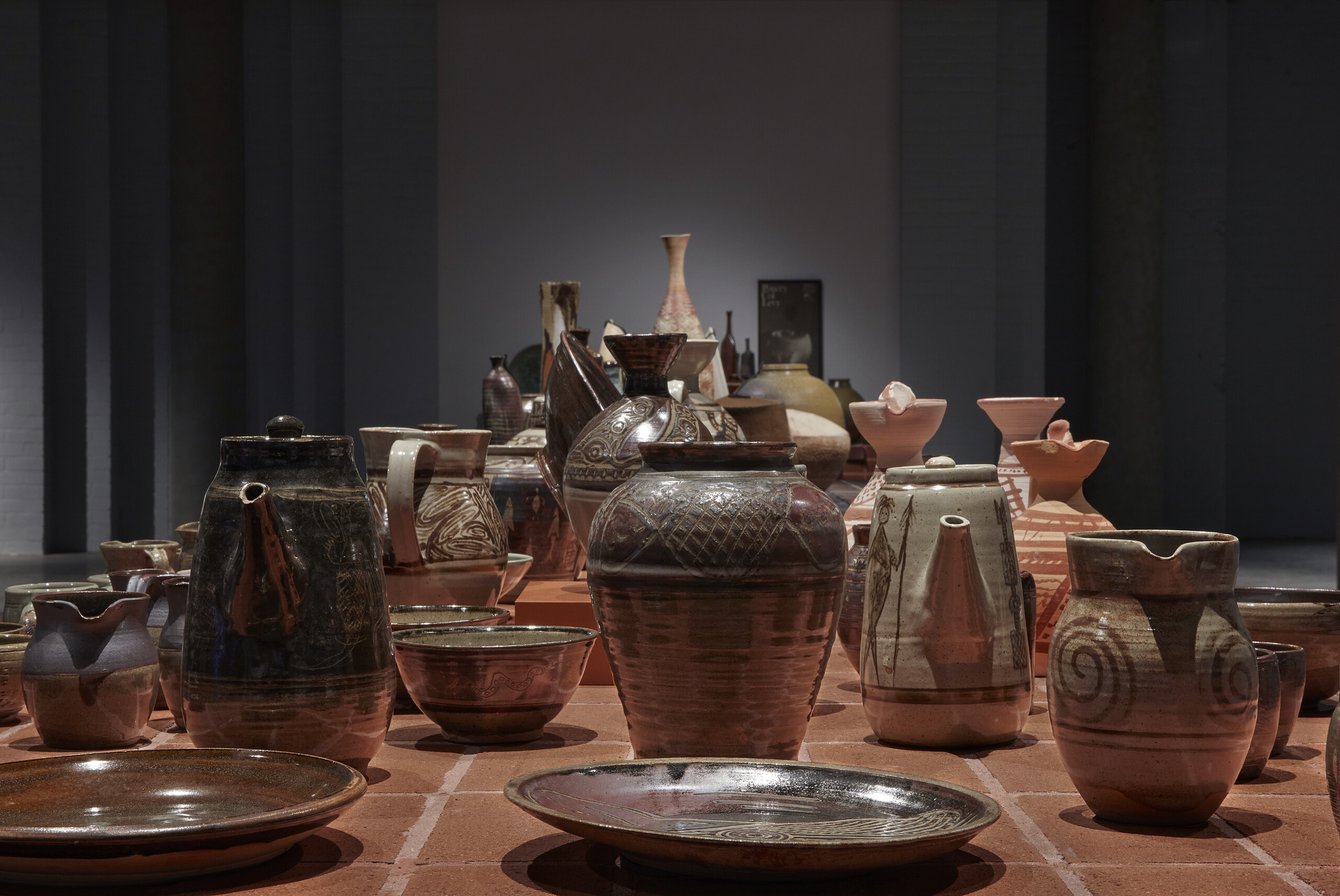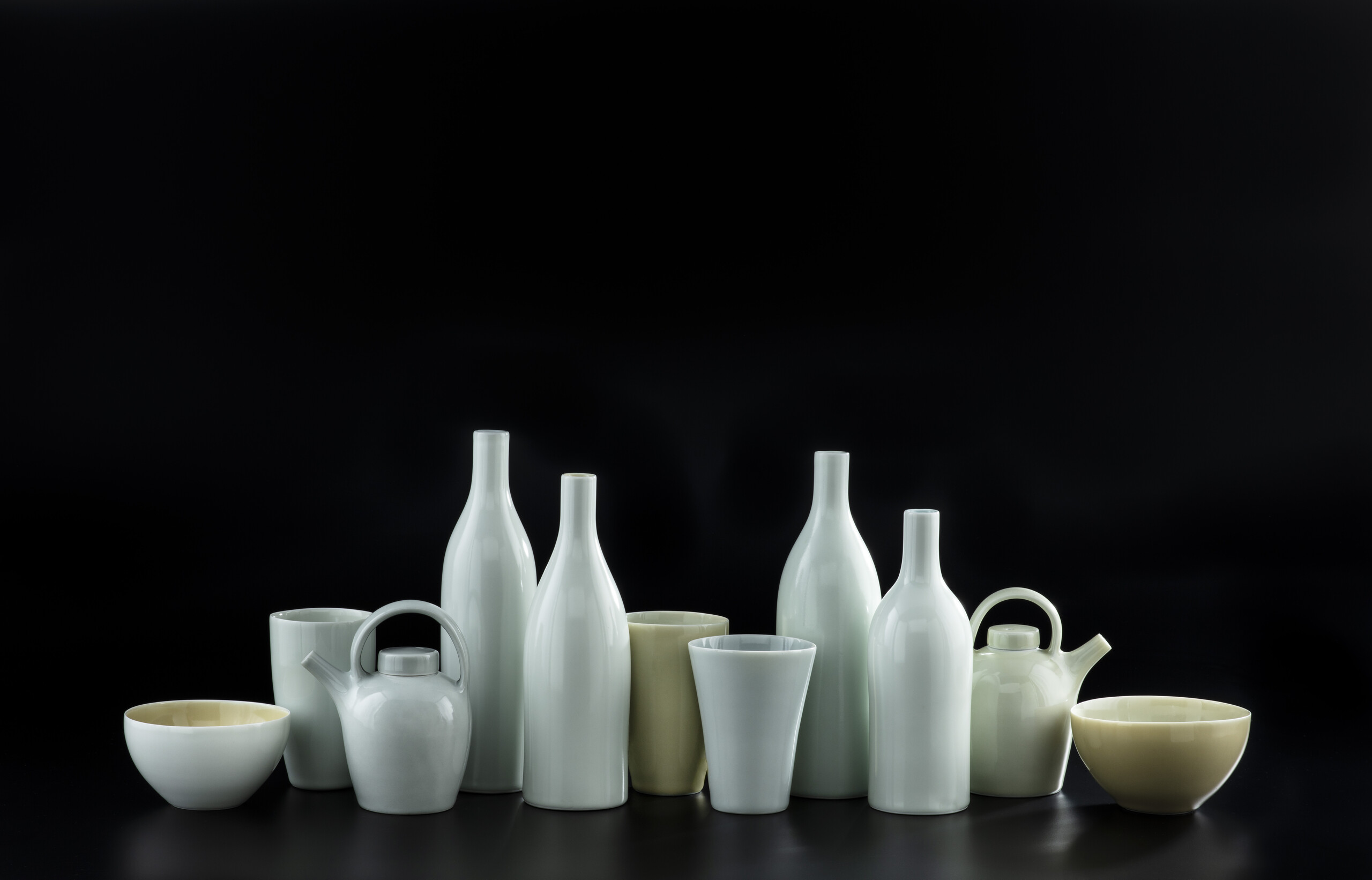Clay Dynasty
Victoria Pham
Forming the earth into objects has long been a part of human activity. The earliest clay-fired craft so far uncovered by archaeologists, Jomon pottery, was found in Japan and has been dated to 16000bp (before present). However, clay is not limited to its shaping, forming and firing into ceramics. In Australia, clay has been used for paintings and drawings by First Nations cultures to create some of the oldest rock art on Earth. Some of this rock art, such as those found on Wilinggin Country, date to 30000bp. Clay Dynasty, currently on view at the Powerhouse Museum, presents a much more recent history. The exhibition’s “dynasty”—an era of history that reflects a succession of the same line of descent—begins in the mid-1960s, and consists of practices where the clay is fired.
As I take the escalator down to the Museum’s lowest exhibition space, my eyes meet the closed eyes of four porcelain busts from Ah Xian’s China, China series (1999). While the China, China busts may not have been exhibition’s intended point of entry, it is difficult not to be drawn into their silent power. The figures face outwards at the viewer at the periphery of the gallery, their delicate porcelain tones standing in stark contrast to the earthy and brick-like hues which dominate the majority of the exhibition. The quartet of figures, each tattooed, sculpted or hollowed with different typography, inspires a sense of wonderment. As I contemplated these meditating forms, my gaze drifted beyond their silhouettes to spy several dozens of other objects. I was struck by the diversity and sheer mass of assemblages of ceramics presented before me—a total of fifty groupings of objects on display. Clay Dynasty sets out to showcase seventy commissions and acquisitions—over four hundred works by one hundred and sixty Australian artists, covering three generations of makers across a half-century. The over-abundance of objects in one space quickly presents a challenge: how do I navigate the volume of offerings before me?

The exhibition traces the origins of its Australian ceramic-making “dynasty” to the British studio potter, Bernard Leach. Leach is often regarded as the father of British studio pottery and spent much of his early life in East Asia. These early experiences bleed through a body of ceramic works that often reflect aesthetic influences from Japan and China. The theme of connection with Asian philosophies and aesthetics ripples across the exhibition as a whole, expressed through displays of pieces from Japan and China using Shino, Tenmoku and Celadon glazes.
The exhibition’s narrative seeks to trace Leach’s influence, taking us from studio to studio. Clay Dynasty frames the mid-1960s as the moment where Leachean philosophies first arrived in Australian ceramic studios through potters such as Ian McKay, Gwyn Hanssen Pigott, and Michael Cardew. The exhibition follows Leachean aesthetics across the 1970s and 1980s, and into contemporary practices. Despite this anchoring in the British ceramic tradition, the exhibition also emphasises First Nations Australian artists. We are guided to the show’s displays of Bagot and Tiwi pottery from the 1960s. These studios reflect the instruction of Cardew, who adopted the aesthetic philosophies of Leach and sought to pass these on to Indigenous ceramic trainees. These stoneware objects highlight the beauty of Australian clays and local glazes, with potters Eddie Puruntatameri and Bobby Wunyimarra extending Cardew’s teachings into uniquely Northern-Australian vessels. This fascinating display of vessels in all shapes and profiles would tickle the fancy of every ceramic devotee, awakening the urge to pick up and hold each receptacle. In its best moments, Clay Dynasty’s joy lies in its ability to showcase how one dynastic root, Leach’s influences, has flowered into a multi-faceted Australian studio pottery tradition that embraces local artisans with diverse regional influences, from Darwin-based Bagot studio pottery to the aesthetics of neighbouring Asia.

Unfortunately, however, as one loses oneself amongst the volume of tightly packed displays, this narrative starts to evaporate. Even if one were to follow the numbered floor-plan that claims to provide a chronologically coherent and dynastic pathway through the exhibition, the experience feels arbitrary. By restricting the dynasty to Leach, tension arises: the exhibition wishes to lay claim to the multi-generational influence of Leach while also celebrating the diversity of ceramic practices across Australia, many of which are non-Leachean. Across the sheer volume of objects on display, Leach is both exalted and erased.
The fallout of this conceptual confusion is that few of the objects are presented in a manner that allows for an appreciation of their finer details or unique beauty. The traces of the specific artist’s hand or studio that shaped each work, grounding it in a particular time and place, are hard to see. On more than one occasion, my fellow visitors and I feared knocking over a precious vessel behind or beside us in our efforts to make adequate space for communal viewing. From this logistical standpoint, it was a confusing array of ceramic mounds, presented in a manner that perhaps hoped to evoke a sense of discovering objects like an archaeologist would in an excavation. However, the public should not be required to decipher meaningful lineages amongst assemblages. The allurement of the objects was rendered invisible by the presence of too many objects in too little space, with the sensibilities of individual potters made dull by the din of visual noise from adjacent plinths.
This problem is perhaps best exemplified by the installation of a 2019 sculptural work by contemporary Australian artist Ramesh Mario Nithiyendran, entitled Hog/Human. The sculpture was situated against the back wall of the exhibition gallery and popped out due to its large scale, and its interplay of human religious icons with graffiti-and-emoji-esque effects—all hallmarks of Nithiyendram’s distinctive body of work. However, in a novel gesture, the artist has also included in Hog/Human a set of LED lights draped through and across the statue. Because of Clay Dynasty’s crowded display, Nithiyendram’s LED lights cast their light onto the work of neighbouring artists, Damon Moon and Nell, bathing their works in ultramarine shadow. This light, so crucial to the whimsy of Hog/Human, diminishes the careful application of colour and glazes of Nell’s anthropomorphic vessels.


A counter-example, one of the few instances where the noise of the exhibition seemed to recede, was the installation of Japanese artist Satoru Hoshino’s Ancient Woodland IV-2 on the adjacent wall. Hoshino’s installation was presented in a manner unencumbered by the array of other plinths, independently occupying an entire wall. By having space to view the central black sculpture and the formation of hundreds of pieces of ceramic positioned behind it, we are given the physical space to meditate upon each sherd’s place within the earthenware cloud. This arrangement gave the work capacity to breathe, and thus too the viewer. Perhaps more clarity in presentation would have helped with the challenges of navigating the gallery space where, currently, the choice of display curtails the intricacies and historical intrigue that the objects on display possessed.
The exhibition ultimately demands one thing of the viewer: to see the tradition of clay-making as a constellation of aesthetics and histories that are marked by the hands of teachers. What Clay Dynasty reveals (contrary to its title’s insistence on a single lineage) is that there is no singular aesthetic that defines Australian ceramic culture. Rather, the show commemorates the sheer variety of studio pottery schools and teachers in Australia, and their impact on the landscape of Australian ceramic making. The hallmark of mid-1960s to current-day ceramic practice in Australia is its ability to bring together local materials with influences spanning Japanese and Chinese aesthetics and English stoneware. I discovered more about the legacies of ceramic studio teachers such as Graham Oldroyd, McKay, and Pigott, enamoured by the earthy hues of Bagot pottery and enchanted by the storytelling of Ernabella Arts, Australia’s oldest continuously running Indigenous art centre. The scale of the works on display not only highlighted the influences of each potter but the artistic liberty unleashed by firing clay. We can see the sheer joyful variety in Oldroyd’s functional stoneware in lustrous copper glaze, Pigott’s conceptual porcelain still life works, and Ernabella artists Baker and Thompson integrating painted patterns that are also used for fabric and wood designs. The message of Clay Dynasty (despite the exhibition’s grounding Leach’s studio) is that to be an Australian ceramicist is to be a part of a community of ceramic-making practices that is expansive, exploratory, and not limited to European colonial sensibilities.


As I concluded my visit to the exhibition, it seemed fitting that I visit the poster-child work for the exhibition, Juz Kitson’s 2021 A Lament for the wildfires. Commissioned specifically for this exhibition, Kitson’s rhythmic command of porcelain and stoneware shine through in this vessel. As though a metaphor for the whole exhibition, the work comprises an ecosystem of plant-and-organ-like forms whose excess simultaneously inspire awe and discomfort. Cloaked in a mournful matte-black glaze, the murmuration of forms on Kitson’s work almost gives a sense that the ceramic is moving and whispering to us in earthen tongues. Kitson’s frozen lamentation reflects some of the most skilful and innovative practices in contemporary Australian ceramics. The triumph of Clay Dynasty is that it is a celebration of the teaching legacies of several ceramic dynasties across Australia, and of the deeper connections between local materials and multicultural aesthetic influences. Clay, after all, is not just about the perfectly glazed vessel or an ideal sculptural form, it is about its ability to throw traditions and histories from hand to hand.
Victoria Pham is an Australian installation artist, composer, archaeologist and evolutionary biologist based in Paris, France.


